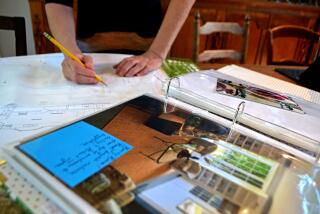Setting a project timeline
- Share via
Timing is everything with building work. Not only must it be done in a certain order -- the plumbing can’t go in after the drywall -- but delays can cost hundreds of dollars a day. So remember the adage of John Deverell, a former deputy director-general of the British intelligence agency MI5, “Any fool can be unprepared,” and don’t be one of them.
Consult a designer. Check the hourly rate. Do not get into even measuring the space without being clear about costs and understanding a basic payment schedule. Commission the first drawing -- a floor plan. The designer will measure the space and deliver contrasting drawings: the site as it is now and a proposal.
Hunt for a general contractor. This is the person who will orchestrate all the work. Check with friends and good local building and plumbing supply outlets. Get at least two bids, preferably three.
Make sure the contractor is licensed by the city.
Ask for a work schedule, proposed payment schedule and to be notified of any vacation time to be taken during the job. If you have the slightest reservation, heed it before the contractor has taken a sledgehammer to your walls. It’s a pain, but check references. If you can, make visits to inspect a builder’s work.
Call a site meeting with the designer and contractor. Set a start date with at least six weeks’ preparation time. Discuss what the final cost will probably be. Include a 20% overrun for “while you are at it” requests. Ask to be updated on costs promptly and clearly.
Choose and order all the cabinets, plumbing fixtures and appliances with your designer during the lag between commission and start. Give your contractor a list of what you’ve ordered and delivery dates, in case he will be signing for it.
Once these choices are made, your designer can draw elevations (front-on plans of every face of the room with precise architectural details). Forward these to your contractor to place orders for doors, windows, etc. that must be custom-made.
Cabinets that are not custom-made tend to come in large, flat boxes. You will need to clear space to accommodate them. If you are keeping your appliances, make a place for your refrigerator, stove, washer, dryer and boxed kitchenware.
Prepare for the upheaval. Give yourself at least two weeks to pack up the kitchen. Cull junk. You will also need room to store your packed kitchenware. Set aside one set of plates and mugs for each family member and basic dishwashing tools.
Ensure the refrigerator is accessible. Set up a coffee bar and dishwashing station in a bathroom.
Make arrangements for pets.
Decide how you want the rubble to be carried off the site. Confirm who will cart it away, and that it will be disposed of safely, thoroughly and legally.
Think utilities. After demolition of the kitchen, the contractor will bring in electricians and plumbers to strip out redundant services and lay supply lines. Your designer should supply you with plans for sockets, light outlets and recessed lighting. Make sure they not only know where you want your appliances, but also what kind you will have, so if your refrigerator needs a water line, there will be one.
If your builder has a design question, do not answer it. Refer it to the designer and let them work it out or have the designer come back to you. Vice versa if the designer has a building question.
Ask the designer for a floor covering plan, as the team starts replacing the drywall and plaster. Make sure the material is ordered and the contractor has a start date. Cabinets and finish molding cannot go in until the floor is done. The minute it is in, cover it with plywood.
Make sure you have all appliances and light fixtures at least two weeks before the electricians and plumbers return (once the cabinets are in) to connect sinks, refrigerators, etc.
Hold another site meeting as the job nears completion to run through a checklist with the contractor and designer. This is the time to swap brass hinges that should’ve been nickel and generally troubleshoot.
More to Read
Inside the business of entertainment
The Wide Shot brings you news, analysis and insights on everything from streaming wars to production — and what it all means for the future.
You may occasionally receive promotional content from the Los Angeles Times.








